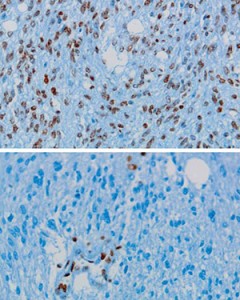Pediatric brain cancer research offers hope for “targeted” treatment with “pinpoint accuracy”
 Past findings from an international, genome-sequencing consortium that has linked a “mutated histone protein” to a rare brain-stem cancer in children called DIPG, fueled the recent breakthrough in a targeted treatment of the tumors, according to the C. David Allis laboratory located at Rockefeller University.
Past findings from an international, genome-sequencing consortium that has linked a “mutated histone protein” to a rare brain-stem cancer in children called DIPG, fueled the recent breakthrough in a targeted treatment of the tumors, according to the C. David Allis laboratory located at Rockefeller University.
The normal treatment choices, after a parent receives the diagnosis that their child has a tumor related to pediatric brain cancer, may be limited to two methods: chemo or radiation therapy.
As such, parents do fear the side effects for their child, as the oncologist explains how healthy tissue may be damaged as the course of action is played out.
Now, with the direct link identified with the histone protein, doctors may now be able to offer a protocol designed to “target tumors with pinpoint accuracy.”
Similarly, the advancement mirrors the collaborative nature of hospitals who currently work with the Rory David Deutsch Foundation as they look for discoveries that will lead to the eradication of pediatric brain cancer.
Medical researchers share common goals when it comes to such research: Hospitals tied to the Foundation share relevant tissues in a bid to advance outcomes more swift.
At the heart of the Rory David Deutsch Foundation, is the inspiration seven-year old Rory Deutsch gave to those around him; his courage is a motivation behind the teams of volunteers who work to raise funds for not only the medical research, but to provide the families with emotional support as well.
Ross and Mindy Deutsch, Rory’s parents, founded the organization shortly after Rory died in 1998. Since then, communities across the country host events as a way to contribute to an eventual cure of childhood brain tumors.
To make a contribution, or to join our network of volunteers, contact us today.
Common License:
This work is licensed under a Creative Commons Attribution-NonCommercial-NoDerivs 3.0 Unported License.






















